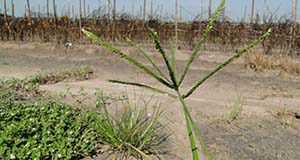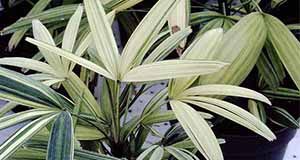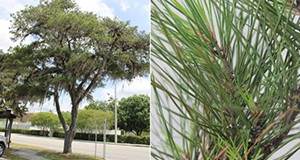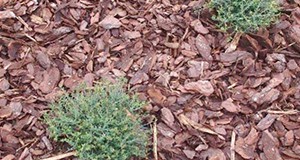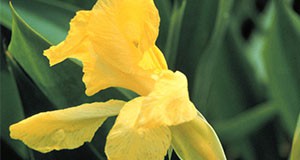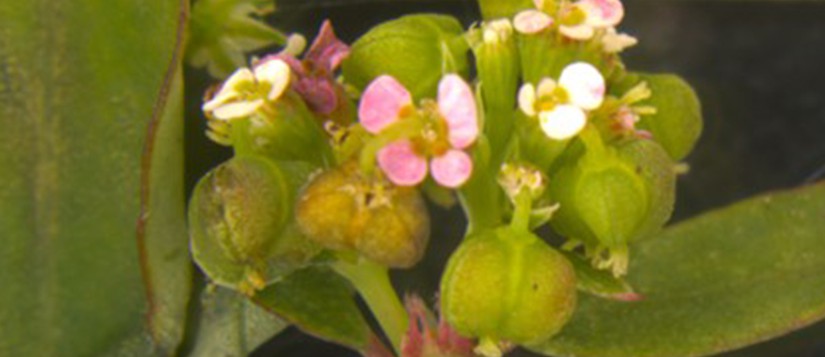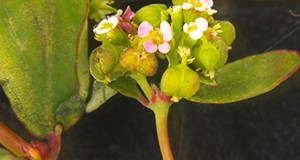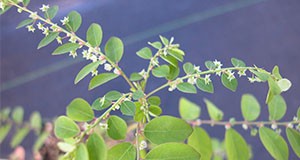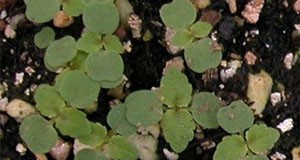This six-page fact sheet provides information about the biology and management of goosegrass, including preemergence and postemergence control options. Written by Shawn Steed, Christopher Marble, Nathan S. Boyd, Andrew MacRae, and Kiran Fnu and published by the Environmental Horticulture Department.
http://edis.ifas.ufl.edu/ep538
Tag: Environmental Horticulture Department
Biology and Management of Pilea microphylla(Artillery weed) in Ornamental Crop Production
This five-page fact sheet describes the biology and management of Pilea microphylla, or artillery weed, for ornamental crop production. Artillery weed occurs primarily in moist, disturbed areas and is thought to be native to South America and parts of North America. It is found throughout Florida. Written by Debalina Saha, Chris Marble, Shawn Steed, and Nathan Boyd and published by the Environmental Horticulture Department.
http://edis.ifas.ufl.edu/ep535
Herbicidas Postemergentes para Uso en Ornamentales

This is the Spanish language version of ENH95/WG095 Postemergent Herbicides for Use in Ornamentals http://edis.ifas.ufl.edu/wg059 Postemergent herbicides are applied directly to weeds. This 5-page fact sheet is largely comprised of two tables: Table one lists postemergent herbicides that can be safely used over the top of some ornamentals when used according to label directions; table 2 lists postemergent herbicides that are registered for use around ornamental plants when applied as a directed spray. Written by E. Vanesssa Campoverde, Chris Marble, and Jeffrey G. Norcini and published by the Environmental Horticulture Department.
http://edis.ifas.ufl.edu/ep533
Rhapis excelsa: Lady Palm
Rhapsis excelsa, the lady palm, is an outstanding, small clustering palm for shady landscape or interiorscape use. This two page fact sheet gives a brief overview of the Lady Palm. Written by Timothy K. Broschat and published by the Environmental Horticulture Department.
http://edis.ifas.ufl.edu/fp501
Starting a Community Garden
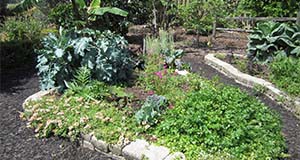
A community garden is a great way to unite a group of people in a common goal. In addition to providing fresh herbs, vegetables, and fruit, community gardens can also increase self-esteem, beautify a neighborhood, and create and opportunity for socializing and improving health. This four-page fact sheet outlines the importance of community gardens and how to develop and manage a community garden. Written by Adrian Hunsberger, Eva C. Worden, and John McLaughlin, and published by the Environmental Horticulture Department.
http://edis.ifas.ufl.edu/ep124
Ten Common Conifers of the Tampa Bay Area
Conifers are cone-bearing trees often identified by their needles. In addition to their value as landscape trees and lumber and paper sources, they are popular around the holidays as Christmas trees.
This 6-page guide written by Andrew K. Koeser, Holly Finley, Gitta Hasing, Gary W. Knox, and Melissa H. Friedman and published by the Environmental Horticulture Department will assist you in identifying the 10 most common conifers that grow in the Tampa Bay area of Florida. It is an efficient resource for master gardeners, novice tree inventory crews, 4-H forestry teams, and others interested in basic conifer identification.
Monitoring Leaching Fraction for Irrigation Scheduling in Container Nurseries
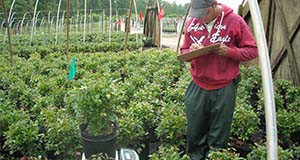
Scheduling irrigation in container nurseries can be a daunting task for producers. There is a great risk of under- or over-watering. The leaching fraction (LF) test is a valuable tool for measuring the volume of container drainage collected during irrigation relative to the volume of water entering the container. With this test, producers can adjust their irrigation to maintain a low percentage of leaching. This four-page fact sheet explains how to perform the test, gives example calculations, and provides some suggestions on how to utilize LF testing when managing irrigation. Written by Jeff Million and Tom Yeager, and published by the Environmental Horticulture Department.
http://edis.ifas.ufl.edu/ep529
Weed Control for Ornamentals inside Greenhouses and Other Enclosed Structures
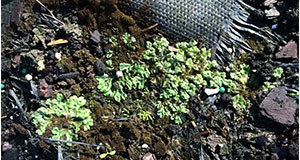
Maintaining a weed-free greenhouse is important for producing healthy and marketable crops. Weeds will compete with crops for water, light, and nutrients. Weeds can find favorable conditions for growth in gravel and along edges, tears, and worn areas of ground cloth. It is important to frequently scout for weeds. This five-page fact sheet describes both chemical methods of controlling weeds, but also non-chemical methods, such as sanitation and prevention, hand weeding, and cultural control practices. Written by Chris Marble and Jeremy Pickens, and published by the Environmental Horticulture Department.
http://edis.ifas.ufl.edu/ep528
Environmental Stresses and Your Florida Lawn
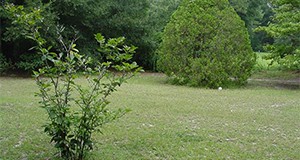
Florida lawns are subject to many environmental stresses. These can include nutrient deficiency, salinity, temperature extremes, over- or under-watering, soil problems, and prolonged exposure to shade or traffic. The use of proper cultural practices will help keep your lawn healthy and more stress-tolerant. This two-page fact sheet explains how to choose the most appropriate grass, fertilize properly, mow to the correct height, and irrigate for your lawn’s needs. Written by L.E. Trenholm, and published by the Environmental Horticulture Department.
http://edis.ifas.ufl.edu/ep070
Sizzle and Passionista: Two New Lance-Leaved Caladium Cultivars
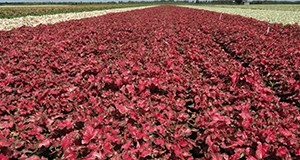 Many lance-leaved cultivars often produce small tubers, making it difficult for growers to produce tubers profitably. ‘Sizzle’ and ‘Passionista’ are two new lance-leaved caladium cultivars with improved tuber yield potential. The availability of ‘Sizzle’ and ‘Passionista’ may expand the color palette for caladium plants desired by greenhouse growers, nurseries, and gardeners. This 7-page fact sheet discusses the cultivars' tuber yield potential, container trials, landscape performance, growing recommendations, and availability. Written by Zhanao Deng, and published by the UF Department of Environmental Horticulture, December 2015.
Many lance-leaved cultivars often produce small tubers, making it difficult for growers to produce tubers profitably. ‘Sizzle’ and ‘Passionista’ are two new lance-leaved caladium cultivars with improved tuber yield potential. The availability of ‘Sizzle’ and ‘Passionista’ may expand the color palette for caladium plants desired by greenhouse growers, nurseries, and gardeners. This 7-page fact sheet discusses the cultivars' tuber yield potential, container trials, landscape performance, growing recommendations, and availability. Written by Zhanao Deng, and published by the UF Department of Environmental Horticulture, December 2015.
http://edis.ifas.ufl.edu/ep527
Florida Vegetable Gardening Guide — Revised!
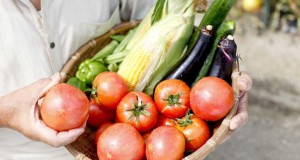
Vegetable gardening offers fresh air, sunshine, exercise, enjoyment, mental therapy, nutritious fresh vegetables, and economic savings, as well as many other benefits. With some attention to planning and planting, vegetables can be grown year-round in Florida. This 11-page guide provides recommendations primarily for traditional home gardens, including planning your garden and choosing crops, soil preparation and maintenance, fertilization, irrigation, pest management, and other gardening know-how. Includes a planting guide, table of suggested varieties, and table of products labeled for insect and mite management in home vegetable gardens. Written by Sydney Park Brown, Danielle Treadwell, J. M. Stephens, and Susan Webb, and published by the Environmental Horticulture Department.
http://edis.ifas.ufl.edu/vh021
A Manual for the Design and Implementation of Teaching and Demonstration Gardens
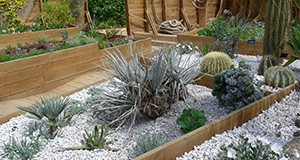
Teaching and demonstration gardens are places where the public can learn about different types of gardens and landscapes. This 10-page fact sheet discusses the various types of gardens, how to plan and develop a demonstration garden, logistical and design considerations, and educational programming. Written by Gail Hansen, and published by the UF Environmental Horticulture Department, July 2015.
http://edis.ifas.ufl.edu/ep524
Improving Weed Control in Landscape Planting Beds
Because landscape beds often contain a variety of ornamental plants, shrubs, and trees, using herbicides to control weeds in these areas can be challenging; however, non-herbicidal methods can be labor intensive. This 6-page fact sheet outlines how to use landscape design and cultural and chemical practices to effectively control weeds in landscape beds. This publication also discusses the use of pre- and postemergent herbicides. Written by Chris Marble and Andrew Koeser, and published by the UF Department of Environmental Horticulture, June 2015.
http://edis.ifas.ufl.edu/ep523
Golden Canna: Canna flaccida
Golden canna is a native wetland plant with bright yellow flowers that can be found throughout most of Florida. This 4-page facts sheet details the golden canna’s biology, distribution and habitat, propagation, pests and diseases, and landscaping and other uses. Written by Edward F. Gilman, Carl J. Della Torre III, and Lyn A. Gettys, and published by the UF Department of Environmental Horticulture, June 2015.
http://edis.ifas.ufl.edu/fp102
Adonidia merrillii: Christmas Palm
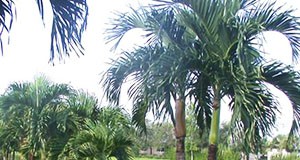
The Christmas palm (Adonidia merrillii) is a fast-growing palm that is well-suited for small sites, requires little maintenance, is relatively disease-free, and produces clusters of bright red fruit in winter, hence the common name Christmas palm. This 2-page fact sheet covers the Christmas palms biology, distribution and habitat, susceptibility to disease, and general care. Written by Timothy K. Broschat, and published by the UF Department of Environmental Horticulture, July 2015.
http://edis.ifas.ufl.edu/st658
Biology and Management of Graceful Sandmat (Chamaesyce hypericifolia) in Ornamental Crop Production
Graceful sandmat (Chamaesyce hypericifolia) is a problematic weed that often grows in container media in ornamental plant nurseries. This 4-page facts sheet profiles the biology of graceful sandmat and recommends physical, cultural, and chemicals methods for managing the weed in the nursery environment. Written by Theresa Chormanski, Chris Marble, and Lyn Gettys, and published by the UF Department of Environmental Horticulture, June 2015.
http://edis.ifas.ufl.edu/ep522
Orchid Pollination Biology
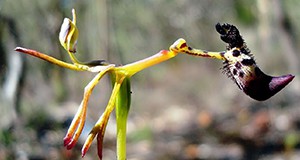
Orchids and their pollinators have developed fascinating co-adaptations that promote orchid pollination. This 6-page fact sheet details the various and often strange ways that orchids attract pollinators. The kinds of insects and animals that pollinate orchids and orchids’ reproductive anatomies and processes are also covered. Written by Haleigh Ray and Wagner Vendrame, and published by the UF Department of Environmental Horticulture, June 2015.
http://edis.ifas.ufl.edu/ep521
Commercial Production of Ornamental Tropical Foliage Plants: Micropropagation
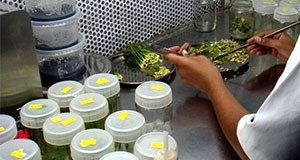 Florida nursery operators need to understand plant propagation principles and techniques so they can grow enough plants for sale. Micropropagation is a way to culture plant tissue to rapidly propagate a large number of plants. This 4-page fact sheet presents an overview of micropropagation to help growers evaluate it as a propagation technique for their own nursery operations. Written by J. Chen and R. J. Henny, and published by the UF Department of Environmental Horticulture, May 2015. (Photo: J. Chen, UF/IFAS)
Florida nursery operators need to understand plant propagation principles and techniques so they can grow enough plants for sale. Micropropagation is a way to culture plant tissue to rapidly propagate a large number of plants. This 4-page fact sheet presents an overview of micropropagation to help growers evaluate it as a propagation technique for their own nursery operations. Written by J. Chen and R. J. Henny, and published by the UF Department of Environmental Horticulture, May 2015. (Photo: J. Chen, UF/IFAS)
http://edis.ifas.ufl.edu/ep520
Biology and Management of Long-Stalked Phyllanthus in Ornamental Crop Production
This 5-page fact sheet discusses the characteristics of long-stalked phyllanthus and explains how to control its growth in a nursery environment. Written by Theresa Chormanski, Chris Marble, and Lyn Gettys, and published by the UF Department of Environmental Horticulture, April 2015.
http://edis.ifas.ufl.edu/ep518
Biology and Management of Mulberry Weed (Fatoua villosa) in Ornamental Crop Production
This 4-page fact sheet discusses the characteristics of mulberry weed (Fatoua villosa) and explains how to control its growth in a nursery environment. Written by Chris Marble and Shawn Steed, and published by the UF Department of Environmental Horticulture, April 2015.
http://edis.ifas.ufl.edu/ep517
